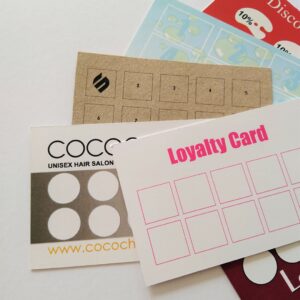First impressions count and as such your business card delivers a marketing message which is important and which immediately creates that first impact of your brand, business and yourself. All too often many businesses and their respective representatives, whoever they may be within the hierarchy of the organisation, present business cards which portray the wrong image and lack that professional edge.
Initially, it is worthwhile understanding what it is you want to achieve from your business card. Delivering contact details is the key element; however the business card should also reflect your brand and create the right impression.
The reality is that the process of creating an effective business card can be simplified by following five simple rules.
Make it Stand Out
An effective business card should stand out from the crowd. With the sheer number of cards that one individual may obtain over a period of time, making your card stand out is critical to success.
There are a number of methods to enhance the effectiveness of a business card, including imagery, use of colour, unusual shapes, style or a catchy strapline. The key is to attract attention and generate interest.
Some people will think about using a background image, however this should only be considered if it enhances the overall message. If using imagery, try to make it related to your business, rather than choosing a standard image or a stock image (if it’s an interesting stock design or image, many in your niche will use it or already be using it). Use something, which in image form, describes what you do or highlights a benefit of your product or service.
Consider using heavier paper stock, studies have shown that sturdy paper stock is better perceived. Textured materials offer something different whilst Forest Stewardship Council (FSC) certified materials are an excellent choice as they are environmentally friendly and sustainable.
Almost everyone uses standard credit card size (e.g. 85mm x 55mm), so having a different business card size or shape, such as a square, will help your card stand out.
Another option is to select a surface texture with a twist. Most will specify standardised finishes such as uncoated, or matt, silk, gloss coated; additional foil, thermography, UV coating, embossed or debossed elements within your business card design will present a different visual and tactile feel.
Design for Your Audience
As with any form of marketing or promotional material, your business card should be designed with your target audience in mind. Industry specific terminology should be used if desired and also imagery relevant to your industry. Some innovative businesses have even created business cards that offer something completely different, such as edible business cards, which are memorable albeit possibly short lived!
Keep the Information on the Card Simple
Many people will try to pack as much information on their business card as possible; this only serves to confuse matters.
You should include the main information i.e. business name, your name, job title (if relevant), contact details (e.g. landline and mobile numbers, and email) and the company website uniform resource locator (URL). Some choose to no longer include address details where contact is preferred by phone, email, website or online social media.
We are in the social media age, all companies should be utilising online social media, you should also include your companies or your own relevant social media details such as Twitter handle and LinkedIn details.
Quick Response (QR) codes are another potential option. These codes are presented as square graphic codes, which are an efficient way to link to online resources or alternative forms of information, such as audible nametags (ANTs).
If sufficient space is available on the business card, consider including a memorable strapline helping to promote your business.
Keep the Styling Consistent with Your Brand
This may sound obvious but many people have a business card, which does not accurately represent their own brand or comply with their branding guidelines. What this means in practical terms, is not only utilising the logo, but maintaining the styling, colours and typographical elements consistent with all other forms of marketing or promotional material. Consistency within all forms of marketing materials is important, specifically for brand awareness.
One other point to remember, when designing your business card, is to use white space (also known as negative space). White space is as important on any form of document as the content that fills it. With a business card ensure the inclusion of white space to render the content easier to read and digest. If used correctly white space increases legibility and with appropriate emphasis on the hierarchy of the elements within the business card also displays a sense of professionalism.
Ensure the Print Quality is Excellent
There are a myriad of printing options, which can enhance the visual appeal of your business card, for example:
Foil stamping, which offers a highly effective visual element to your business card using metallic foils that are stamped onto the business card and can be used to highlight a particular design element.
Embossing, which is an ideal method to create a three dimensional (3D) effect.
It should go without saying; presenting poor quality printed business cards conveys a negative message. Ensure that you commission a professional printing company to manufacture your business cards.
If you require help or advice on design or printing your business cards, then, as always you know where we are.












